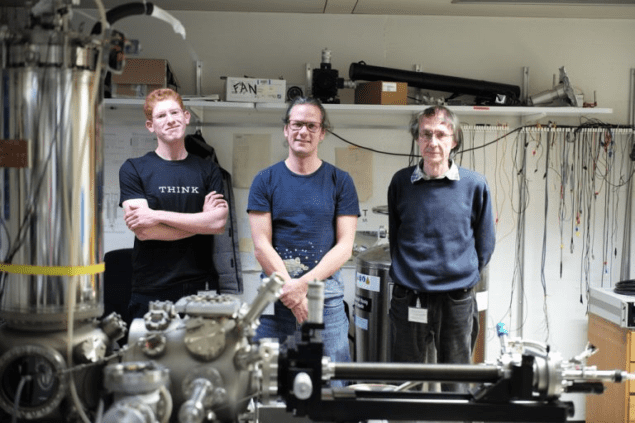
An atomic force microscope can be used as a single-electron current meter, according to new experiments by researchers at IBM. The technique, which measures the energy levels of single molecules on insulators for the first time, provides precious information on single-electron intermolecular transport. The work might ultimately help to make improved electronics devices in the future, by characterizing defects in chips, for example.
Electronic devices contain printed circuit boards, in which all of the components making up a device can clearly be seen. The conducting tracks, which carry electric current through the entire board, are visible too. The boards also include insulating layers that shield the tracks from current leakage.
In molecular electronics, we would see a similar set-up with single molecules as the conducting tracks and single electrons being transferred from the molecules, explain the researchers led by Gerhard Meyer at IBM Research-Zurich. However, the difference on this scale is that the underlying substrate produces supplementary effects that need to be analysed. Unfortunately, this is no easy task since the molecules being electrically characterized are on top of an insulator.
The reorganization energy
“While charging a molecule on an insulator, the atoms in the molecule will relax towards accommodating this additional charge, as will the nuclei in the insulator,” says Shadi Fatayer, who is the lead author of this study. “This change in the atoms’ position impacts their energy levels and is known as the ‘Marcus reorganization energy’. It drastically affects the rate at which single electrons are transferred between molecules.”
In their experiments, the researchers grew multilayers of sodium chloride, NaCl, which is an insulating material, on top of a metal substrate. Such a system allows the molecules that are then absorbed on top (single naphthalocyanine molecules in this case) to have stable charge states, since they are decoupled from the metal surface.
Reorganization energies are usually measured by analysing molecules in solution or with molecules on top of a metal, but until now, there was no way of doing this for individual molecules on top of an insulator.
Enter atomic force microscopy
Atomic force microscopy is a widely-used ultrahigh-resolution technique that allows researchers to observe extremely small objects, even down to single atoms. It works by sensing the topography of a sample as it scans across it thanks to a very fine probe (the cantilever), which has an extremely sharp tip at its end. The AFM measures the tiny forces between the tip and the sample, such as a molecule on a support as in this case.
Thanks to previous work in their lab, the researchers had already succeeded in using an AFM to measure different charge states on top of an ultrathin insulator – with single-electron sensitivity. They also managed to image stably-charged molecules and transfer single electrons between molecules on top of a thicker insulator. Being able to measure reorganization energies proved to be more difficult still, however, and meant that they had to measure the energy levels that corresponded to particular charge-state transitions.
“Before this work, we were able to measure the electric current through a single naphthalocyanine (NPc) molecule atop an ultrathin insulating NaCl,” says Leo Gross, who is a physicist at IBM. “However, this only works in one direction for a given electron orbital. When we could measure the energy needed to attach an electron to a certain orbital, we could never measure the energy to remove one electron from that orbital, for example. With our AFM technique, we can now measure the energy levels in both charge-state directions on a thin film substrate.
Very weak signals
“The signals we need to detect are very weak, however, because they come from weak forces associated with currents that are just zepto-amperes in magnitude. This means that we must perform many careful measurements for a proper statistical analysis.”
The team in fact employed the tip and the force exerted on the tip to count single electrons; “We adjust the tip height and voltage and then count how long it takes for one electron to go to (or from) the tip and from this you can obtain the energy levels,” adds Gross.
The technique is detailed in Nature Nanotechnology doi:10.1038/s41565-018-0087-1.



